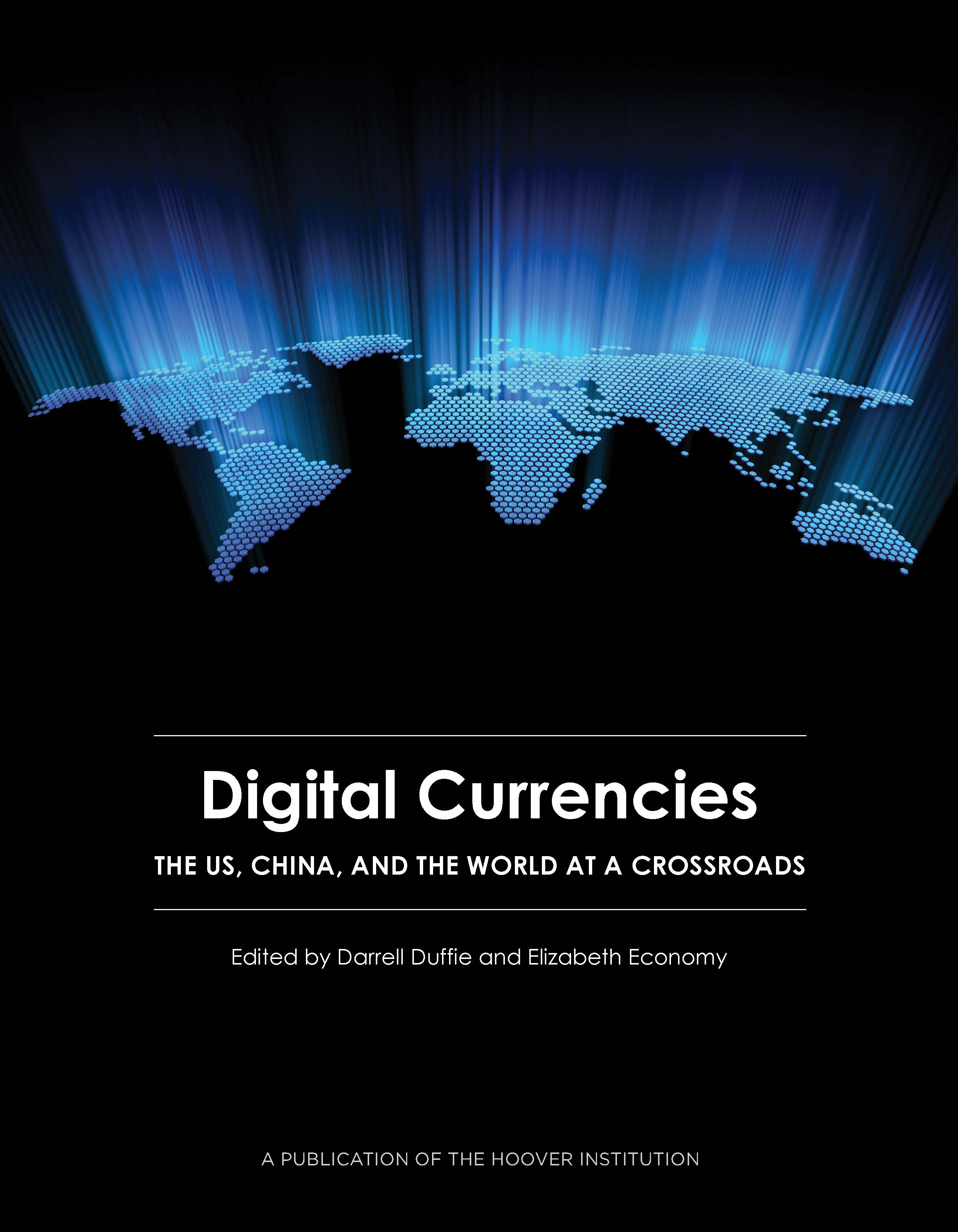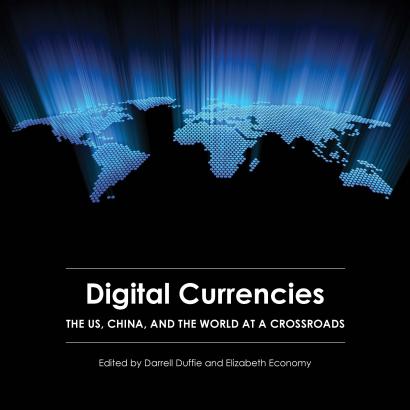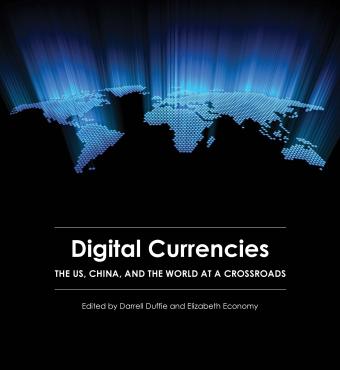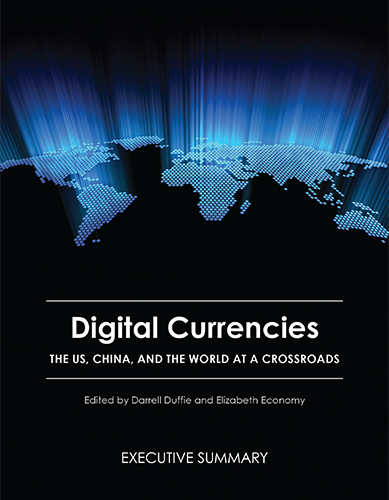Hoover Institution (Stanford, CA) – The Hoover Institution’s Digital Currency and Electronic Payments Working Group has published, “Digital Currencies: The US, China, and the World at a Crossroads,” a new report about how the United States can respond to the growing use of the digital yuan, or e-CNY, China’s version of central bank digital currency (CBDC).
The report is co-edited by nationally leading economist Darrell Duffie and acclaimed China scholar Elizabeth Economy, both Hoover senior fellows. Participants include several scholars within the Hoover community as well as other distinguished experts from various disciplines, including national security, finance, central banking, technology policy, and computer science.
“We are deeply grateful to Darrell Duffie and Elizabeth Economy for their brilliant leadership in producing this report, which could not come at a more important moment,” said Senior Fellow Larry Diamond, a contributor to the report and cochair of Hoover’s Project on China’s Global Sharp Power. “Dozens of countries are researching or developing central bank digital currencies (CBDCs), and right now, China, the world’s most powerful authoritarian state, is in the lead.
“Through their meticulous research, deep policy and technical expertise, and lucid analysis, this distinguished team of authors makes a compelling case for the United States to move now to develop CBDC technology and to lead in crafting the rules and standards for the future global digital economy. At stake is not only US leadership in global finance, but also our most cherished values of privacy, freedom, national security, and the rule of law.”
The multidisciplinary volume presents findings on how China is boldly blazing new trails in the digital currency revolution and proposes a roadmap for reviving American financial leadership in the digital age.
"We discovered that emerging digital currencies, including China's, pose a complex set of interlocking risks and opportunities for the United States, spanning from national security, to privacy, to the plight of many unbanked American families,” Duffie said. “Our policy recommendations for the US government are specific and actionable.”
On January 5, 2022, the day after China’s central bank launched an e-CNY wallet, it was the most downloaded app from Apple’s iOS App Store. Today, millions of retailers throughout China are adopting payment systems accepting the currency.
In addition to over 100 million Chinese consumers who already use this digital currency, the e-CNY has crossed borders. The Bank for International Settlements has started a program, called m-CBDC Bridge, that will enable e-CNY payments to be processed between China and other countries, including Thailand, Hong Kong, and the United Arab Emirates. Chinese telecom giant Huawei has also preinstalled an e-CNY wallet in its Mate 40 smartphone line, spurring the adoption of the digital yuan in new markets.
The report explores some of the possible motives behind China’s decision to aggressively deploy a central bank digital currency. For example, the e-CNY will grant more Chinese citizens access to the banking system, thus giving authorities in Beijing greater oversight over commercial and individual transactions. Equipped with this surveillance capability, the Communist Party can deepen its political control over Chinese society.
This system also provides Beijing the opportunity to flex its muscles as an economic superpower. China’s international leadership of electronic payments technology could establish international norms and standards that align with its authoritarian form of government as well as its global political interests.
The report outlines how the e-CNY might ultimately undermine the traditional dominance of the US dollar as the world’s dominant reserve currency and a source of geostrategic influence. The decline in power of the US dollar would also diminish a key tool in the American national security playbook: the ability to deploy crippling sanctions against rogue state actors and human rights abusers.
Hoover Institution Director Condoleezza Rice wrote in the introduction to the report, “The result of a year-long effort by a distinguished group of experts on China, finance, technology, and national security, this report provides a pathway for the United States to revitalize its international financial leadership by helping to shape the emerging global digital economy. It does not advocate that the US Federal Reserve create a `digital dollar,’ but stresses that US authorities move energetically to develop its own CBDC technology and standards to counter this growing Chinese influence.”
In this comprehensive report, the experts make three broad recommendations about how the United States can strengthen its economic competitiveness and global influence in the digital currency revolution:
- The United States should launch a well-resourced CBDC research and development effort drawing on the talent of US government, private sector, and university actors to ensure privacy, prevent illegal payments, and provide for a competitive and innovative payment landscape. The Boston Fed’s partnership with MIT, Project Hamilton, is an early example of such collaboration.
- The United States should establish a strategic plan for payment systems in the US digital economy that provides for the development of data privacy standards and the integration of CBDCs, fast-payment systems, and private payment arrangements such as stablecoins.
- The United States should step up to lead the development of an international regulatory framework around digital currencies, including CBDCs, that prioritizes consumer protection, privacy, financial anti-crime compliance, financial stability, and the protection of monetary sovereignty.
The six chapters of the report include the following: Introduction: At a Global Crossroads in Digital Currencies; China’s New Digital Currency: Function and Motives; Prospects for e-CNY Internationalization; International Security Implications of the e-CNY; Forging International Cooperation on Digital Currencies; and A Roadmap for US Leadership.
Click here to read the entire report, “Digital Currencies: The US, China, and the World at a Crossroads.”
Report contributors include the following:
Reena Aggarwal
Robert E. McDonough Professor of Finance and director, Center for Financial Markets and Policy, McDonough School of Business, Georgetown University
Dan Boneh
Professor of computer science and electrical engineering, Stanford University
Jared Cohen
Founder and CEO, Jigsaw
Larry Diamond
Senior fellow, Hoover Institution, and Mosbacher Senior Fellow in Global Democracy, Freeman Spogli Institute for International Studies, Stanford University
Darrell Duffie
Adams Distinguished Professor of Management and professor of finance, Stanford Graduate School of Business, and senior fellow (by courtesy), Hoover Institution, Stanford University
Elizabeth Economy
Senior fellow, Hoover Institution, Stanford University
Yaya J. Fanusie
Chief strategist, Cryptocurrency AML Strategies; and adjunct senior fellow, Center for a New American Security
Niall Ferguson
Milbank Family Senior Fellow, Hoover Institution, Stanford University
J. Christopher Giancarlo
Former chairman, US Commodity Futures Trading Commission
Lauren Gloudeman
Director for China, Eurasia Group
Zhiguo He
Fuji Bank and Heller Professor of Finance and Jeuck Faculty Fellow, Booth School of Business, University of Chicago
Samantha Hoffman
Senior analyst, Australian Strategic Policy Institute (ASPI)
Matthew D. Johnson
Visiting fellow, Hoover Institution, Stanford University
Stuart Levey
CEO, Diem Networks
Sigal Mandelker
General partner, Ribbit Capital
David Mazières
Professor of computer science, Stanford University
H. R. McMaster
Fouad and Michelle Ajami Senior Fellow, Hoover Institution, Stanford University; and former White House national security adviser
Evan S. Medeiros
Professor and Penner Family Chair in Asian Studies in the School of Foreign Service, Georgetown University; and former directorof Asian affairs, White House National Security Council
Neha Narula
Director, Digital Currency Initiative, MIT Media Lab
Monika Piazzesi
Joan Kenny Professor of Economics, Stanford University
Matthew Pottinger
Distinguished Visiting Fellow, Hoover Institution, Stanford University; and former White House deputy national security adviser
Eswar Prasad
Professor, Cornell University; senior fellow, Brookings Institution; and research associate, National Bureau of Economic Research
Raghuram Rajan
Senior fellow, Hoover Institution; the Katherine Dusak Miller Distinguished Service Professor of Finance, Booth School of Business, University of Chicago; and former governor of the Federal Reserve, Bank of India
Nadia Schadlow
Visiting fellow, Hoover Institution, Stanford University; senior fellow, Hudson Institute; and former deputy national security adviser for strategy
Richard Sokolow
Managing director and director of research, Davidson Kempner Capital Management
John B. Taylor
George P. Shultz Senior Fellow in Economics, Hoover Institution, and Mary and Robert Raymond Professor of Economics, Stanford University; and former undersecretary of the treasury for international affairs
Glenn Tiffert
Research fellow, Hoover Institution, Stanford University
Robert M. Townsend
Elizabeth and James Killian Professor of Economics, Massachusetts Institute of Technology
Matt Turpin
Visiting fellow, Hoover Institution, Stanford University; and former director for China, White House National Security Council
Kevin Warsh
Shepard Family Distinguished Visiting Fellow in Economics, Hoover Institution, and lecturer at Stanford Graduate School of Business, Stanford University; and former member of the board of governors at the US Federal Reserve
Chenggang Xu
Visiting fellow, Hoover Institution, Stanford University; visiting professor, Imperial College; honorary professor, University of Hong Kong; and research fellow, Centre for Economic Policy Research
For coverage opportunities, contact Jeffrey Marschner, 202-760-3187, jmarsch@stanford.edu.






















